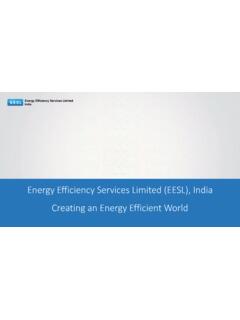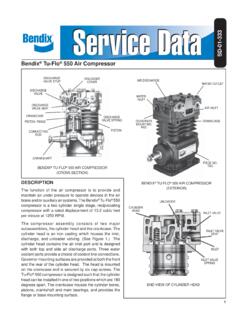Transcription of Chapter 3.3: Compressed Air System - knowledgeplatform.in
1 Question bank for Energy Managers & Energy Auditors Chapter : Compressed Air System Part I: Objective type questions and answers 1. Which of the following type does Screw compressor belongs to? a) Positive displacement compressor b) Dynamic compressors c) Both a & b d) None of the above 2. The compressor capacity of a reciprocating compressor is directly proportional to __ a) Speed b) Pressure c) Volume d) All 3. Vertical type reciprocating compressors are used in the capacity range of _____ a) 50 150 cfm b) 200 500 cfm c) Above 10ooo cfm d) 10 50 cfm 4. The specific power consumption of non lubricated compressor compared to lubricated type is ____ a) Lesser b) Same c) Higher d) None 5.
2 The discharge temperature of two stage compressor compared to single stage one is ____ a) Lesser b) Same c) Higher d) None 6. The compression ratios for axial flow compressors are ____. a) Lesser b) Higher c) moderate d) None 7. The volumetric efficiency of the compressor _____ with the increase in altitude of place a) increases b) decreases c) does not change d) None 8. The ratio of isothermal power to actual measured input power of a compressor is known as: a) Isothermal efficiency b) Volumetric Efficiency c) Barometric efficiency d) None 9. The basic function of air dryer in a compressor is: a.
3 Prevent dust from entering compressor b. storage and smoothening pulsating air output c. reduce the temperature of the air before it enters the next state to increase efficiency d. to remove remaining traces of moisture after after-cooler 10. For every 4 C raise in air inlet temperature of an air compressor, the power consumption will increases by_____ a) 2% b) 1% c) 3% d) 4% 11. The percentage increase in power consumption of a compressor with suction side air filter and with the pressure drop across the filter of 200 mmWc is ____ a) b) 3% c) d) Which of the statement is True for centrifugal compressors?
4 A) The compressor should not be operated at full load b) The compressor should be operated at shut off pressure c) The compressor should not be operated with inlet-guide vane control Compressed air System - revised (table format) 17 Question bank for Energy Managers & Energy Auditors d) The compressor should not be operated close to the surge point 13. Identify the correct statement for air compressors. a. For every drop in the inlet air temperature, the increase in energy consumption is by 2%. b. For every 4 oC rise in the inlet air temperature, the decrease in energy consumption is by 1% c.
5 For every 4 oC rise in the inter air temperature, the increase in energy consumption is by 1% d. The energy consumption remains same irrespective of inlet air temperature 14. Reduction in the delivery pressure of a Compressor working at 7 bar, by 1 bar would reduce the power consumption by a) 6 to 10 % b) 2 to 3 % c) 12 to 14 % d) None of the above 15. The acceptable pressure drop at the farthest point in mains header of an industrial Compressed air network is: a) bar b) bar c) bar d) 2 bar 16. The likely estimate on equivalent power wastage for a leakage from 7 bar Compressed air System through mm orifice size is ____ a) kW b) kW c) kW d) 12 kW 17.
6 From the point of lower specific energy consumption, which of the following compressors are suitable for part load operation? a) Two stage reciprocating compressors b) Centrifugal compressors c) Two stage screw compressor d) Single stage screw compressor 18. From base load operation and from achieving best specific energy consumption point of view, which of the following compressors are suitable? a) Single stage reciprocating compressors b) Centrifugal compressorsc) Two stage reciprocating compressor d) Multi stage reciprocating compressor 19. Which of the following parameters are not required for evaluating volumetric efficiency of the compressor?
7 A) Power b) cylinder bore diameter c) Stroke length d) FAD 20. If the compressor of 200 cfm loads in 10 seconds and unloads in 20 seconds, the air leakage would be_____ a) 67 cfm b) 100 cfm c) 10 cfm d) 133 cfm Part II: Short type questions and answers 1. Give major classifications of compressors and the basic principle of its working. The major classifications of compressors are positive displacement and dynamic type. Positive displacement can be further divided in to (a) Reciprocating (b) Rotary. Dynamic compressors divided into Radial and Axial. In case of positive displacement compressors increase the pressure of air/gas by reducing the volume.
8 Dynamic compressors increase the air or gas velocity, which is then converted to increase the pressure. Compressed air System - revised (table format) 18 Question bank for Energy Managers & Energy Auditors 2. If the compressor of 200 m3/min loads in 10 seconds and unloads in 20 seconds, calculate the amount of air leakages in the System . The System leakage is calculated by: System leakage in m3/min = )(tTQxT+ Where Q = Actual free air being supplied during trial in m3/min T = Load time in minutes t = Unload time in minutes = 200 x 10 / (10 + 20) = 67 m3/min 3. Briefly describe about rotary compressor ?
9 Rotary compressors have rotors in place of pistons and give a continuous, pulsation free discharge. They operate at high speed and generally provide higher throughput than reciprocating compressors. They are directly coupled to the prime mover and require lower starting torque as compared to reciprocating machines. Also they require smaller foundations, vibrate less, and have a lower number of parts which are subject to wear. 4. What are the limitations of a centrifugal compressor operation? The major limitation of a centrifugal compressor is that is operates at peak efficiency at design point only and any deviation from the operating point is detrimental to its performance.
10 When selecting centrifugal compressors, close attention should be paid during System design to ensure that at high pressure, with the consequent reduction in flow, the surge point is not reached. 5. What is a surge point and how do you prevent surging, in centrifugal compressors? Surge point is the point on the performance curve where a further decrease inflow (typically in the region of 50-70 % of rated capacity) causes instability, resulting in a pulsating flow, which may lead to overheating, failure of bearings due to thrust reversals, or excessive vibration. Bypass valves advents are commonly used to prevent surging.




